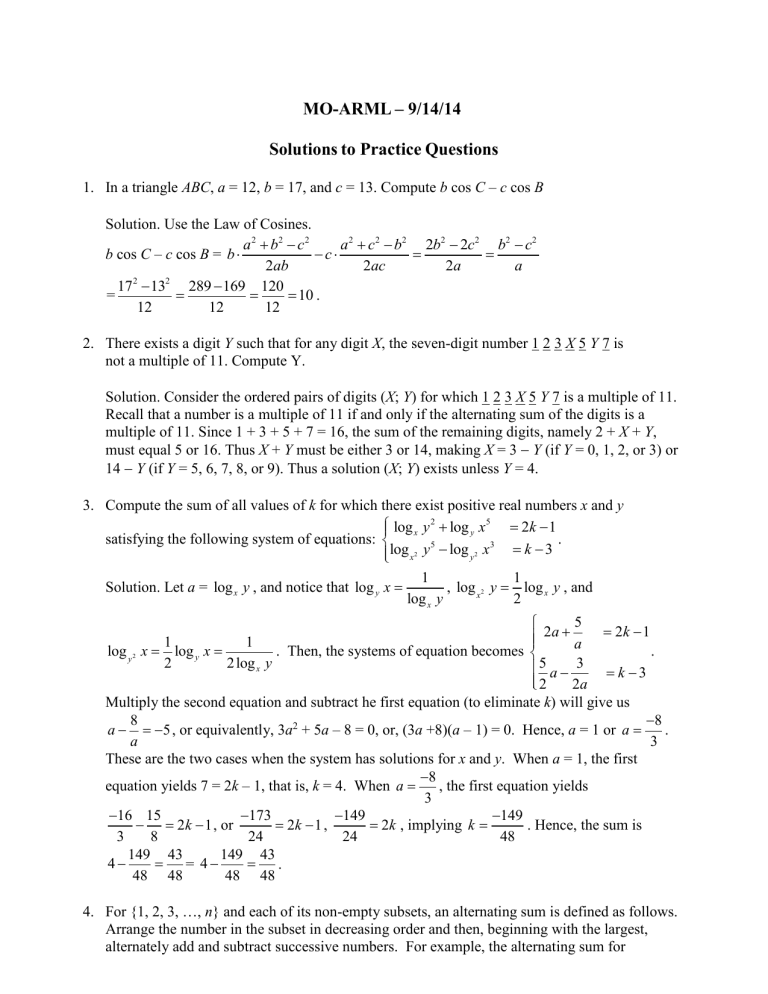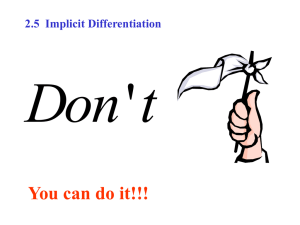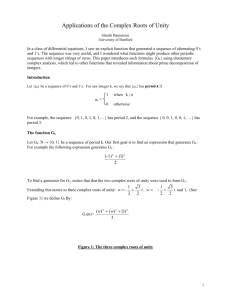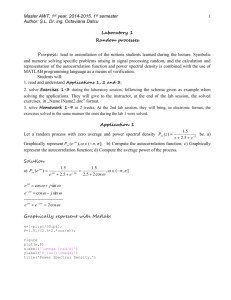Solutions - Missouri State University

MO-ARML – 9/14/14
Solutions to Practice Questions
1.
In a triangle ABC , a = 12, b = 17, and c = 13. Compute b cos C – c cos B
Solution. Use the Law of Cosines. b
= cos C – c cos B = b
a
2 b
2
2 ab
17
2
12
13
2
12
120
12
c
2
10 . a
2 b
2
2 ac
2 b
2
2 a
2 c
2
b
2 a c
2
2.
There exists a digit Y such that for any digit X , the seven-digit number 1 2 3 X 5 Y 7 is not a multiple of 11. Compute Y.
Solution. Consider the ordered pairs of digits ( X ; Y ) for which 1 2 3 X 5 Y 7 is a multiple of 11.
Recall that a number is a multiple of 11 if and only if the alternating sum of the digits is a multiple of 11. Since 1 + 3 + 5 + 7 = 16, the sum of the remaining digits, namely 2 + X + Y , must equal 5 or 16. Thus X + Y must be either 3 or 14, making X = 3
Y (if Y = 0, 1, 2, or 3) or
14
Y (if Y = 5, 6, 7, 8, or 9). Thus a solution ( X ; Y ) exists unless Y = 4.
3.
Compute the sum of all values of k for which there exist positive real numbers x and y satisfying the following system of equations:
log log x
2 x y y
2
5
log log y y
2 x x
5
3
2 k
3
1
.
Solution. Let log y
2 a = log x y , and notice that log y x
1
2 log y x
1
2 log x x
1 y
, log x
2 y
1
2 log x y , and y log x
. Then, the systems of equation becomes
2 a
5 a
5 a
2 2
3 a
2 k
1
3
.
Multiply the second equation and subtract he first equation (to eliminate k ) will give us a 5 , or equivalently, 3 a
2
+ 5 a
– 8 = 0, or, (3 a +8)( a – 1) = 0. Hence, a = 1 or a
a
These are the two cases when the system has solutions for x and y . When a = 1, the first
8 equation yields 7 = 2 k – 1, that is, k = 4. When a
, the first equation yields
3
16
15
3 8
2 k
1 , or
173
24
2 k
1 ,
149
24
2 k , implying k
149
48
. Hence, the sum is
8
.
3
4
149
43
48 48
= 4
149
43
48 48
.
4.
For {1, 2, 3, …, n } and each of its non-empty subsets, an alternating sum is defined as follows.
Arrange the number in the subset in decreasing order and then, beginning with the largest, alternately add and subtract successive numbers. For example, the alternating sum for
{1, 2, 4, 6, 9} is 0 – 6 + 4 – 2 + 1 = 6 and for {5} it is simply 5. Find the sum of all such alternating sums for n = 7 .
Solution. The non-empty subsets of {1, 2, 3, …, 7}, except {7}, can be divided into 2 6 – 1 = 63 pairs of one not containing 7 and one does, such as {1, 2, 3} and {1, 2, 3, 7}. The alternating sums of each pair would add up to exactly 7. For example, (3 – 2 + 1) + (7 – 3 + 2 – 1) = 7.
Hence the sum of all alternating sums for n = 7 is equal to 7
63 + 7 = 7
64 = 448 (the second summand is for the singleton set {7}).
5.
Let N be the least integer greater than 20 that is a palindrome in both base 20 and base 14.
For example, the three-digit base-14 numeral (13)5(13)
14
(representing 13
14
2
+ 5
14 + 13
Is a palindrome in base 14, but not in base 20, and the three-digit base-14 numeral (13)31
14
is not a palindrome in base 14. Compute the base-10 representation of N .
Solution. Because N is greater than 20, the base-20 and base-14 representations of N must be at least two digits long. The smallest possible case is that N is a two-digit palindrome in both bases. Then N = 20 a + a = 21 a , where 1
a
19. Similarly, in order to be a two-digit palindrome in base 14, N = 14 b + b = 15 b , with 1
b
13. So N would have to be a multiple of both 21 and 15. The least common multiple of 21 and 15 is 105, which has the base 20 representation of 105 = 55
20
and the base-14 representation of 105 = 77
14
, both of which are palindromes. Thus the answer is 105.
6.
Compute sin
2
4
+ sin
2
8
+ sin
2
12
+
+ sin
2
176
Solution. Since sin
2 x =
=
1 cos8
2 2
2
2 x
, sin
2
4
+ sin
2
8
+ sin
2
12
+
+ sin
2
176
2
=
44
1
2 2
cos8
cos16
cos 24
= 0. Hence, z
44
+ z
43
Theorem, we know the real part of
z
44 cos 352
+ z
43
. Using complex number z = cos 8
+ i sin 8
, we know z
45
= 1. That is, z
45
– 1 = 0, or ( z – 1)( z
44
+ z
43
+
+ z
2
+ z + 1)
+
+ z
2
+ z + 1 = 0. Since, z k
= cos 8 k
+ i sin 8 k
by DeMovire’s
+
+ z
2
+ z + 1, which is 0, is equal to cos8
cos16
cos 24
cos 352 + 1. Therefore, cos8
cos16
cos 24
cos 352
=
1, and sin
2
4
+ sin
2
8
+ sin
2
12
+
+ sin
2
176
=
44
1
2 2
45
.
2
7. Find the area of the region defined by x
2 y
2 x y .
Solution. By symmetry we only have to calculate the area of this region within the first quadrant, which is now bounded by x
2 y
2 x ;
0, y
0 . The first inequality is the same as x
2 y
2
0 or x
1
2
2
y
1
2
2
1
2
.
Hence we are look for the part of the circle centered at
1 1
,
2 2 with radius
1
2 that is in the first quadrant.
It can be broken into a right isosceles triangle with side
1 length 1 and a half-circle with radius
2
. The area together =
1
2
+
1 π
4
.
Hence, the total area of the original region = 4
1
1
2 4
π
8.
Compute the smallest positive integer n such that 214 n and 2014 n have the same number of divisors.
Solution. Assume Since 214 = 2
107 and 2014 = 2
19
53, they don’t have the same number of divisors. Multiplying 214 and 2014 by anything relatively prime to both 214 and 2014 will not make their numbers of divisors the same. Also, 107 n and 19
53 n should have the same number of divisors. Hence, all prime divisors of n must be from 107’s and/or 19
53’s. For convenience, write n
a
1 b
1
19 53 107 c
1
, where a , b , c
1. Then, 107 n
b
1 c
1
19 53 107 d has ab ( c + 1) divisors and
n
a b
19 53 19 53 107 c
1
has ( a + 1)( b + 1) c divisors, and these two products are equal.
Hence, ab ( c + 1) = ( a + 1)( b + 1) c , or equivalently, abc + ab = abc + ac + bc + c , ab
ac
bc
c = 0.
The goal is to minimize n , so try c = 1. Then, ab – a – b – 1 = 0, ( a – 1)( b – 1) = 2, implying a = 2, b = 3, or a = 3, b = 2. Again, to minimize n , we use a = 3, b = 2, and then n
2
. Note that it can be verified that, if c
2, then the possible n
’s will be greater than 19133.
9.
Compute the greatest integer k
1000 such that
1000 k
is a multiple of 7.
Solution.
1000
k
. The largest multiple of 7 less than 1000 is 994, but
1000
993
1000
7
1 2 3 7
994
is not divisible by 7. The next largest multiple of 7 is 987, but
1000
986
1000
14
994
1 2 3 7 14
987
is still not divisible by 7. This process produce a factor of 7 until the numerator is a multiple of 49. Since 980 is divisible by
49,
1000
979
1000
21
994 987
1 2 3 7 14 21
980 integer k
1000 such that
1000 k
is divisible by 7. The greatest
is a multiple of 7 is 979.
10.
The equation z
6
+ z
3
+ 1 = 0 has complex roots z = r (cos
+ i sin
) with argument
between
90 and 180 . Determine the degree measure of
.
Solution.
Since ( z
3
– 1)( z
6
+ z
3
+ 1) = z
9
– 1, the roots of z
6
+ z
3
+ 1 = 0 are among the roots of z
9
– 1 = 0 that are not roots of z
3
– 1 = 0.
The arguments of the roots of z
9
– 1 = 0 in
90 ,180 of a root of z
3
– 1 = 0, so the only available
is 160 .
are 120 ,160 , but 120 is the argument
1.










